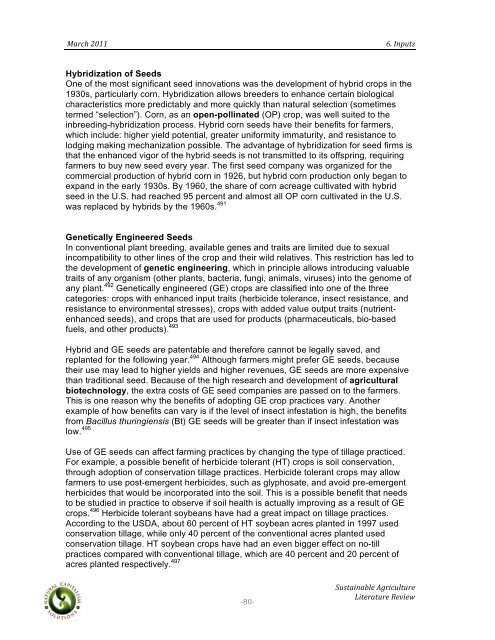Sustainable Agriculture Literature Review - Boulder County
Sustainable Agriculture Literature Review - Boulder County
Sustainable Agriculture Literature Review - Boulder County
You also want an ePaper? Increase the reach of your titles
YUMPU automatically turns print PDFs into web optimized ePapers that Google loves.
! ! !!<br />
"#$%&!'())!! !!!!!!!!!!!!!!!!!!!!!!!!!!!!!!!!!!!!!!!!!!!!!!!!!!!!!!!!!!!!!!!!!!!!!!!!!!!!!!!!!=+!>5?324!<br />
Hybridization of Seeds<br />
One of the most significant seed innovations was the development of hybrid crops in the<br />
1930s, particularly corn. Hybridization allows breeders to enhance certain biological<br />
characteristics more predictably and more quickly than natural selection (sometimes<br />
termed “selection”). Corn, as an open-pollinated (OP) crop, was well suited to the<br />
inbreeding-hybridization process. Hybrid corn seeds have their benefits for farmers,<br />
which include: higher yield potential, greater uniformity immaturity, and resistance to<br />
lodging making mechanization possible. The advantage of hybridization for seed firms is<br />
that the enhanced vigor of the hybrid seeds is not transmitted to its offspring, requiring<br />
farmers to buy new seed every year. The first seed company was organized for the<br />
commercial production of hybrid corn in 1926, but hybrid corn production only began to<br />
expand in the early 1930s. By 1960, the share of corn acreage cultivated with hybrid<br />
seed in the U.S. had reached 95 percent and almost all OP corn cultivated in the U.S.<br />
was replaced by hybrids by the 1960s. 491<br />
Genetically Engineered Seeds<br />
In conventional plant breeding, available genes and traits are limited due to sexual<br />
incompatibility to other lines of the crop and their wild relatives. This restriction has led to<br />
the development of genetic engineering, which in principle allows introducing valuable<br />
traits of any organism (other plants, bacteria, fungi, animals, viruses) into the genome of<br />
any plant. 492 Genetically engineered (GE) crops are classified into one of the three<br />
categories: crops with enhanced input traits (herbicide tolerance, insect resistance, and<br />
resistance to environmental stresses), crops with added value output traits (nutrientenhanced<br />
seeds), and crops that are used for products (pharmaceuticals, bio-based<br />
fuels, and other products). 493<br />
Hybrid and GE seeds are patentable and therefore cannot be legally saved, and<br />
replanted for the following year. 494 Although farmers might prefer GE seeds, because<br />
their use may lead to higher yields and higher revenues, GE seeds are more expensive<br />
than traditional seed. Because of the high research and development of agricultural<br />
biotechnology, the extra costs of GE seed companies are passed on to the farmers.<br />
This is one reason why the benefits of adopting GE crop practices vary. Another<br />
example of how benefits can vary is if the level of insect infestation is high, the benefits<br />
from Bacillus thuringiensis (Bt) GE seeds will be greater than if insect infestation was<br />
low. 495<br />
Use of GE seeds can affect farming practices by changing the type of tillage practiced.<br />
For example, a possible benefit of herbicide tolerant (HT) crops is soil conservation,<br />
through adoption of conservation tillage practices. Herbicide tolerant crops may allow<br />
farmers to use post-emergent herbicides, such as glyphosate, and avoid pre-emergent<br />
herbicides that would be incorporated into the soil. This is a possible benefit that needs<br />
to be studied in practice to observe if soil health is actually improving as a result of GE<br />
crops. 496 Herbicide tolerant soybeans have had a great impact on tillage practices.<br />
According to the USDA, about 60 percent of HT soybean acres planted in 1997 used<br />
conservation tillage, while only 40 percent of the conventional acres planted used<br />
conservation tillage. HT soybean crops have had an even bigger effect on no-till<br />
practices compared with conventional tillage, which are 40 percent and 20 percent of<br />
acres planted respectively. 497<br />
!<br />
",&"<br />
!,342#.5#6/1!78$.%3/23$1!<br />
9.21$#23$1!:1;.1
















